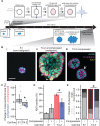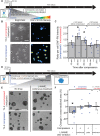Transient external force induces phenotypic reversion of malignant epithelial structures via nitric oxide signaling
- PMID: 29560858
- PMCID: PMC5862525
- DOI: 10.7554/eLife.26161
Transient external force induces phenotypic reversion of malignant epithelial structures via nitric oxide signaling
Abstract
Non-malignant breast epithelial cells cultured in three-dimensional laminin-rich extracellular matrix (lrECM) form well organized, growth-arrested acini, whereas malignant cells form continuously growing disorganized structures. While the mechanical properties of the microenvironment have been shown to contribute to formation of tissue-specific architecture, how transient external force influences this behavior remains largely unexplored. Here, we show that brief transient compression applied to single malignant breast cells in lrECM stimulated them to form acinar-like structures, a phenomenon we term 'mechanical reversion.' This is analogous to previously described phenotypic 'reversion' using biochemical inhibitors of oncogenic pathways. Compression stimulated nitric oxide production by malignant cells. Inhibition of nitric oxide production blocked mechanical reversion. Compression also restored coherent rotation in malignant cells, a behavior that is essential for acinus formation. We propose that external forces applied to single malignant cells restore cell-lrECM engagement and signaling lost in malignancy, allowing them to reestablish normal-like tissue architecture.
Keywords: breast cancer; breast epithelial cells; cancer biology; cell biology; human; malignancy; mechanobiology; phenotypic reversion.
Conflict of interest statement
BR, GV, SF, KT, WO, CR, DB, MB, DF No competing interests declared
Figures










References
-
- Alcaraz J, Xu R, Mori H, Nelson CM, Mroue R, Spencer VA, Brownfield D, Radisky DC, Bustamante C, Bissell MJ. Laminin and biomimetic extracellular elasticity enhance functional differentiation in mammary epithelia. The EMBO Journal. 2008;27:2829–2838. doi: 10.1038/emboj.2008.206. - DOI - PMC - PubMed
-
- Allen P, Melero-Martin J, Bischoff J. Type I collagen, fibrin and PuraMatrix matrices provide permissive environments for human endothelial and mesenchymal progenitor cells to form neovascular networks. Journal of Tissue Engineering and Regenerative Medicine. 2011;5:e74–e86. doi: 10.1002/term.389. - DOI - PMC - PubMed
Publication types
MeSH terms
Substances
Grants and funding
LinkOut - more resources
Full Text Sources
Other Literature Sources
Miscellaneous

